The Impact of the Level of Training of Airport Security Control Operators on the Energy Consumption of the Baggage Control Process
Abstract
:1. Introduction
2. Literature Review
3. The Process of Training Security Control Operators
4. Methodology
- Blurring: at this stage, the input values are transformed into fuzzy values using the MF. Each input variable has a specific MF that assigns to the input values the degree of membership of particular fuzzy sets.
- Aggregation of premises (combining conditions): the conditions of individual rules are combined. If a given rule has several conditions, a fuzzy operator (e.g., T-norm) combines the degrees of membership of the conditions into one value.
- Activation of rules: based on the aggregation value of the premises, the relevant rules are activated. Activation assigns a truth value (membership degree) to each rule. The truth value of a rule is equal to the aggregation value of the premises for the rule.
- Activation of output sets: after activating the rules, the output sets are assigned activation values based on the conclusion of the rules. For each rule, the degree of membership for the conclusion is computed based on the rule’s truth value. In practice, this means “trimming” the MF of the output sets to the truth values of the rules.
- Aggregation of output sets: all activated output sets are combined into one output set using the aggregation operator (e.g., maximum, minimum or simultaneous minimum and maximum—MIN/MAX); details are in Figure 4.
- Sharpening: transforming the fuzzy output set into one numerical value.
5. The Model for Assessing the Impact of the SCO Training Level on the Energy Consumption of the Baggage Control Process
5.1. First-Level Local Models
- Mean time to correctly indicate a dangerous item (MTCI): the average time expressed in seconds (s) necessary for the operator to indicate a dangerous object in the image, calculated based on the operator’s eye movements tracked by the eye-tracker system;
- Zone analysis order (colors) (ZAO): a dimensionless value, determined based on the operator’s eye movements tracked by the eye-tracker system (details in the description of the variable);
- Correct effectiveness indication (CEI): a variable describing the effectiveness of detection by the operator of objects, materials and substances considered prohibited; expressed as a percentage (%), calculated based on the quotient of correctly indicated dangerous objects among all those hidden in the images;
- Mean eye focus time on dangerous item (MEFT): the average time expressed in seconds (s) that the operator focused on a dangerous object hidden in the image, calculated based on the operator’s eye movements tracked by the eye-tracker system.
5.1.1. Mean Time to Correctly Indicate a Dangerous Item (MTCI)
- °
- Fast: time less than 7 s;
- °
- Medium: time in the range of 7 ÷ 11 s;
- °
- Slow: time over 11 s.
5.1.2. Zone Analysis Order (Colors) (ZAO)
- Orange, for elements with an atomic number Z: 1 < Z < 10;
- Green, for elements with an atomic number Z: 11 < Z < 18;
- Blue, for elements with an atomic number Z: Z > 19.
- Liquids and other organic substances: the view depends on the material density, mainly visible in the primary image in green or orange;
- Metal knives/gun parts: mainly visible in the image in the form of a blue shade of varying intensity;
- Imitations of safe objects: no dominant color, the view depends on the material the object is made of.
- °
- Short: less than 20% of observation time focused on hazardous areas;
- °
- Medium: in the range of 21 ÷ 80% of observation time focused on hazardous areas;
- °
- Long: over 80% of observation time focused on hazardous areas.
5.1.3. Correct Effectiveness Indication (CEI)
- °
- Unacceptable: score less than or equal to 75%;
- °
- Medium: score in the range of 76 ÷ 95%;
- °
- High: score over 95%.
5.1.4. Mean Eye Focus Time on Dangerous Item (MEFT)
- °
- Short: less than 7 s;
- °
- Average: in the range of 7 ÷ 11 s;
- °
- Long: above 11 s.
5.1.5. The First-Level Local Output Variable: Evaluation of the Effectiveness of Hazard Identification
- °
- Beginner: total score less than or equal to 50%;
- °
- Intermediate: total score in the range of 51 ÷ 65%;
- °
- Advanced: total score in the range of 66 ÷ 80%;
- °
- Experienced: total score above 80%.
5.2. Second-Level Local Models
5.2.1. Energy Consumption (EC)
5.2.2. Final Output Variable: Summary Evaluation (SE)
- °
- Weak: sum of points below 1;
- °
- Average: total score in the range of 1 ÷ 4;
- °
- Experienced: total score above 4.
5.3. Knowledge Base: FIS (Fuzzy Inference System) Rules
6. Results
- °
- Operators with 0 ÷ 24 months of experience in the position;
- °
- Operators with 24 ÷ 90 months of experience in the position;
- °
- Operators with 90 ÷ 150 months of experience in the position.
7. Conclusions and Discussions
- Preparation of input data: collecting information on individual factors affecting the level of SCO training, such as skills, experience, theoretical knowledge, etc. These data should be transformed into a form suitable for the inputs of fuzzy models.
- Starting the simulation: based on the input data, a simulation is carried out, which allows the assessment of the impact of individual factors on the final assessment of the SCO training level.
- Analysis of the results: analysis of the simulation results in terms of understanding how individual factors affect the assessment of SCO training. On this basis, training strategies can be developed to improve weaknesses and use strengths.
- Experiments with different scenarios: it is possible to conduct various simulation experiments to study the influence of different combinations of factors on the final score. This can help determine the optimal training path for the SCO that will deliver the best results.
- Verification and validation: after experimentation, the results can be verified and validated by comparing them with actual training results or other assessment methods.
- Further improvement of the model: modifying the number of inputs to the model, MF, inference rules or hierarchical structure to obtain better results.
- The research showed that differences in SCO experience significantly affect the energy consumption of the baggage control process. Operators with more experience consume less energy, which translates into significant savings, especially in large airports with multiple control lines.
- Simulators, being less energy-consuming than actual RTG scanners, offer significant potential for training new operators, allowing them to develop skills in a stress-free and pressure-free environment, which additionally shapes habits and develops a certain automatism in the decisions made.
- The built evaluation tool opens the way to developing individual training strategies for each operator, which can significantly reduce the costs of the entire process, with particular emphasis on training operators with less experience.
- The authors of the study emphasize that economic analysis, represented by the energy costs of the entire baggage control process, is a significant factor that has been completely overlooked so far, suggesting that it should be included in the assessment of SCO operators’ efficiency.
- The tool presented in the article has a universal character and can be used to analyze various control systems, not only those based on low-power RTG scanners.
Author Contributions
Funding
Data Availability Statement
Conflicts of Interest
References
- Airports. Available online: https://snopud.bizenergyadvisor.com/article/airports (accessed on 29 June 2026).
- Ortega Alba, S.; Manana, M. Energy Research in Airports: A Review. Energies 2016, 9, 349. [Google Scholar] [CrossRef]
- Kierzkowski, A.; Kisiel, T. Feasibility of Reducing Operator-to-Passenger Contact for Passenger Screening at the Airport with Respect to the Power Consumption of the System. Energies 2021, 14, 5943. [Google Scholar] [CrossRef]
- Ramsey, D.; Bouscayrol, A.; Boulon, L.; Desreveaux, A.; Vaudrey, A. Flexible Simulation of an Electric Vehicle to Estimate the Impact of Thermal Comfort on the Energy Consumption. IEEE Trans. Transp. Electrif. 2022, 8, 2288–2298. [Google Scholar] [CrossRef]
- ACI. Annual Report 2016; Airports Council International: Montreal, QC, Canada, 2017. [Google Scholar]
- Correia, A.R.; Wirasinghe, S.C.; De Barros, A.G. Overall level of service measures for airport passenger terminals. Transp. Res. Part A 2008, 42, 330–346. [Google Scholar] [CrossRef]
- De Barros, A.G.; Somasundaraswaran, A.; Wirasinghe, S.C. Evaluation of level of service for transfer passengers at airports. J. Air Transp. Manag. 2007, 13, 293–298. [Google Scholar] [CrossRef]
- Ma, J.S.; Liu, X.T.; Zhuang, D.M.; Wang, S.G. CFD-based design of the natural ventilation system of the traffic center of T3 Beijing International Airport. Adv. Mater. Res. 2011, 291–294, 3292–3295. [Google Scholar] [CrossRef]
- Parker, J.; Cropper, P.; Shao, L. Using building simulation to evaluate low carbon refurbishment options for airport buildings. In Proceedings of the 12th Conference of International Building Performance Simulation Association, Sydney, Australia, 14–16 November 2011. [Google Scholar]
- Feng, Y.; Huang, Y.; Shang, H.; Lou, J.; Knefaty, A.d.; Yao, J.; Zheng, R. Prediction of Hourly Air-Conditioning Energy Consumption in Office Buildings Based on Gaussian Process Regression. Energies 2022, 15, 4626. [Google Scholar] [CrossRef]
- Liu, J.; Yu, N.; Lei, B.; Rong, X.; Yang, L. Research on indoor environment for the terminal 1 of Chengdu Shuangliu international airport. In Proceedings of the 11th International IBPSA Conference, Glasgow, UK, 27–30 July 2009. [Google Scholar]
- Metsä-Eerola, I.; Pulkkinen, J.; Niemitalo, O.; Koskela, O. On Hourly Forecasting Heating Energy Consumption of HVAC with Recurrent Neural Networks. Energies 2022, 15, 5084. [Google Scholar] [CrossRef]
- Balaras, C.A.; Dascalaki, E.; Gaglia, A.; Droutsa, K. Energy conservation potential. HVAC installations and operational issues in Hellenic airports. Energy Build. 2003, 35, 1105–1120. [Google Scholar] [CrossRef]
- Gowreesunker, B.L.; Tassou, S.A.; Kolokotroni, M. Coupled TRNSYS-CFD simulations evaluating the performance of PCM plate heat exchangers in an airport terminal building displacement conditioning system. Build. Environ. 2013, 65, 32–145. [Google Scholar] [CrossRef]
- Chen, J.; Xie, K. A prediction model based on unbiased grey Markov for airport energy consumption prediction. In Proceedings of the 2013 Chinese Automation Congress (CAC), Changsha, China, 7–8 November 2013. [Google Scholar]
- Huang, H.; Chen, L. A new model predictive control scheme for energy and cost saving in commercial buildings: An airport terminal building study. Build. Environ. 2015, 89, 203–216. [Google Scholar] [CrossRef]
- Fan, B.; Jin, X.; Du, Z. Optimal control strategies for multi-chiller system based on probability density distribution of cooling load ratio. Energy Build. 2011, 43, 2813–2821. [Google Scholar] [CrossRef]
- Mambo, A.D.; Efthekhari, M.; Thomas, S.; Steffen, T. Designing an occupancy flow-based controller for airport terminals. Build. Serv. Eng. Res. Technol. 2015, 36, 51–66. [Google Scholar] [CrossRef]
- Mambo, A.D.; Efthekhari, M.; Thomas, S.; Steffen, T. Evaluation of Indoor Environment System Performance for Airport Buildings. Int. J. Sustain. Green Energy 2015, 4, 73–84. [Google Scholar] [CrossRef]
- Mambo, A.D.; Efthekhari, M.; Thomas, S.; Steffen, T. Fuzzy supervisory control strategies to minimise energy use of airport terminal buildings. In Proceedings of the 18th International Conference on Automation and Computing (ICAC), Loughborough, UK, 7–8 September 2012. [Google Scholar]
- Soukour, A.; Devendeville, L.; Lucet, C.; Moukrim, A.A. Memetic Algorithm for staff scheduling problem in airport security service. Expert Syst. Appl. 2013, 40, 7504–7512. [Google Scholar] [CrossRef]
- Kierzkowski, A.; Kisiel, T.; Uchroński, P. Simulation Model of Airport Security Lanes with Power Consumption Estimation. Energies 2021, 14, 6725. [Google Scholar] [CrossRef]
- Scala, P.; Mujica Mota, M.; Cheng-Lung, W.; Delahaye, D. An optimization–simulation closed-loop feedback framework for modeling the airport capacity management problem under uncertainty. Transp. Res. Part C 2021, 124, 102937. [Google Scholar] [CrossRef]
- Mujica, M.; Scala, P.; Delahaye, D. Improving Airport Performance through a Model-based and Optimization Approach. In Applied Simulation and Optimization 2; Mota, M.M., De La Mota, I.F., Eds.; Springer: Cham, Switzerland, 2017. [Google Scholar] [CrossRef]
- Skorupski, J.; Grabarek, I.; Kwasiborska, A.; Czyżo, S. Assessing the suitability of airport ground handling agents. J. Air Transp. Manag. 2020, 83, 101763. [Google Scholar] [CrossRef]
- Schultz, M.; Evler, J.; Asadi, E.; Preis, H.; Fricke, H.; Cheng-Lung, W. Future aircraft turnaround operations considering post-pandemic requirements. J. Air Transp. Manag. 2020, 89, 101886. [Google Scholar] [CrossRef]
- Skorupski, J.; Żarów, P. Dynamic management of aircraft stand allocation. J. Air Transp. Manag. 2021, 90, 101964. [Google Scholar] [CrossRef]
- Act of July 3 2002 on Civil Airports (Journal of Laws of 2020. Item 993)—Poland. Available online: https://www.gov.pl/attachment/82798da7-0271-4984-a9cb-8e450445ca44 (accessed on 29 June 2023).
- Commission Regulation (EU) 2015/1998 of 5 November 2015 Establishing Training Guidelines for Screening Operators and Accompanying Staff. Available online: https://eur-lex.europa.eu/legal-content/EN/TXT/PDF/?uri=CELEX:32015R1998&from=ET (accessed on 26 June 2023).
- Commission Regulation (EU) 2015/340 of 20 February 2015 on the Training of Screening Operators and Accompanying Staff. Available online: https://eur-lex.europa.eu/legal-content/EN/TXT/PDF/?uri=CELEX:32015R0340 (accessed on 26 June 2026).
- Directive 2016/681 of the European Parliament and of the Council of 27 April 2016 on the Use of Passenger Data for the Prevention of Terrorism and Serious Crime. Available online: https://eur-lex.europa.eu/legal-content/EN/TXT/PDF/?uri=CELEX:32016L0681 (accessed on 27 June 2023).
- Council Regulation (EEC) No 3922/91 of 16 December 1991 on the Harmonization of Technical Requirements and Administrative Procedures in the Field of Civil Aviation. Available online: https://eur-lex.europa.eu/legal-content/EN/TXT/HTML/?uri=CELEX:31991R3922 (accessed on 24 June 2023).
- Regulation of the Minister of Infrastructure of July 22. 2022. (on Security Checks at Airports)—Poland. Available online: https://isap.sejm.gov.pl/isap.nsf/DocDetails.xsp?id=WDU20220001785 (accessed on 25 June 2023).
- Regulation of the Minister of Transport and Maritime Economy of July 5 2013. (on the Technical Conditions to Be Met by Selected Airport Equipment)—Poland. Available online: https://isap.sejm.gov.pl/isap.nsf/DocDetails.xsp?id=WDU20130000926 (accessed on 23 June 2025).
- Regulation of the Minister of Transport. Construction and Maritime Economy of July 26 2021. on the Training of Security Control Operators at Civil Airports—Poland. Available online: https://isap.sejm.gov.pl/isap.nsf/DocDetails.xsp?id=WDU20210001526 (accessed on 25 June 2023).
- Dubois, D.; Prade, H. Putting Rough Sets and Fuzzy Sets Together. In Intelligent Decision Support; Springer: Dordrecht, The Netherlands, 1992; pp. 203–232. [Google Scholar] [CrossRef]
- Greco, S.; Matarazzo, B.; Slowinski, R. Rough sets theory for multicriteria decision analysis. Eur. J. Oper. Res. 2001, 129, 1–47. [Google Scholar] [CrossRef]
- Zadeh, L.A. Similarity relations and fuzzy orderings. Inf. Sci. 1971, 3, 177–200. [Google Scholar] [CrossRef]
- Siler, W.; Buckley, J. Fuzzy Expert Systems and Fuzzy Reasoning; John Wiley & Sons, Inc.: Hoboken, NJ, USA, 2004. [Google Scholar] [CrossRef]

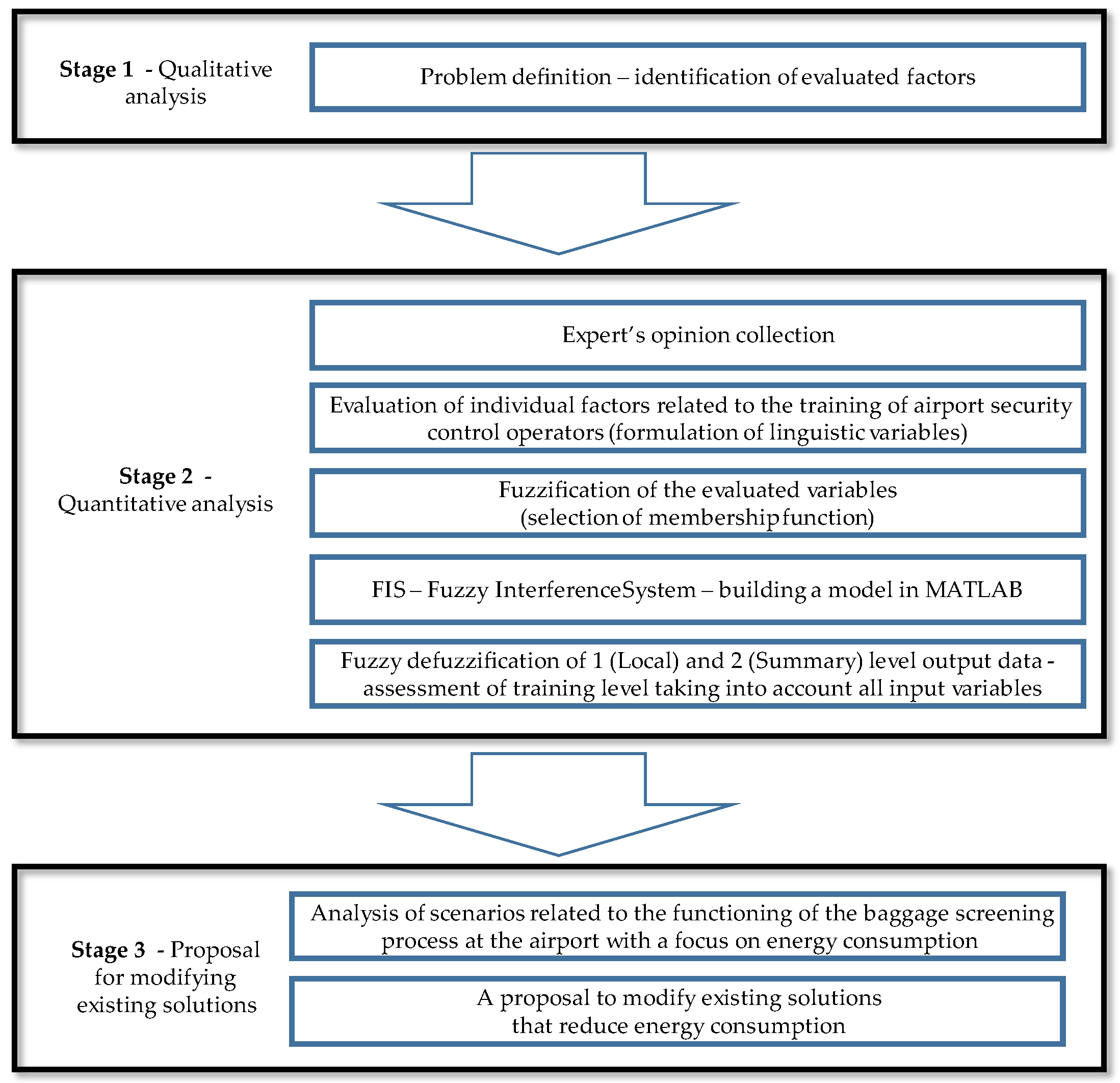
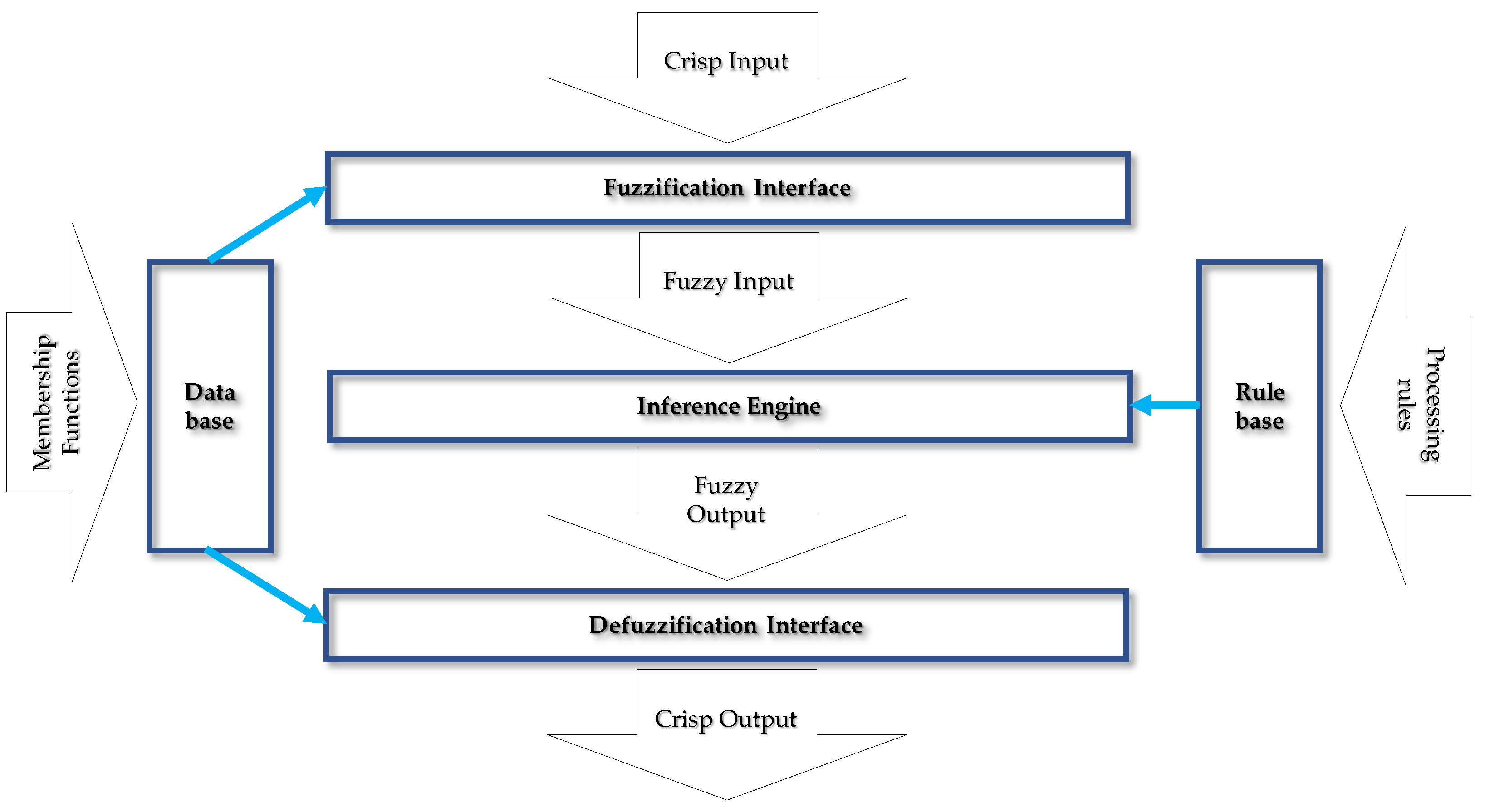
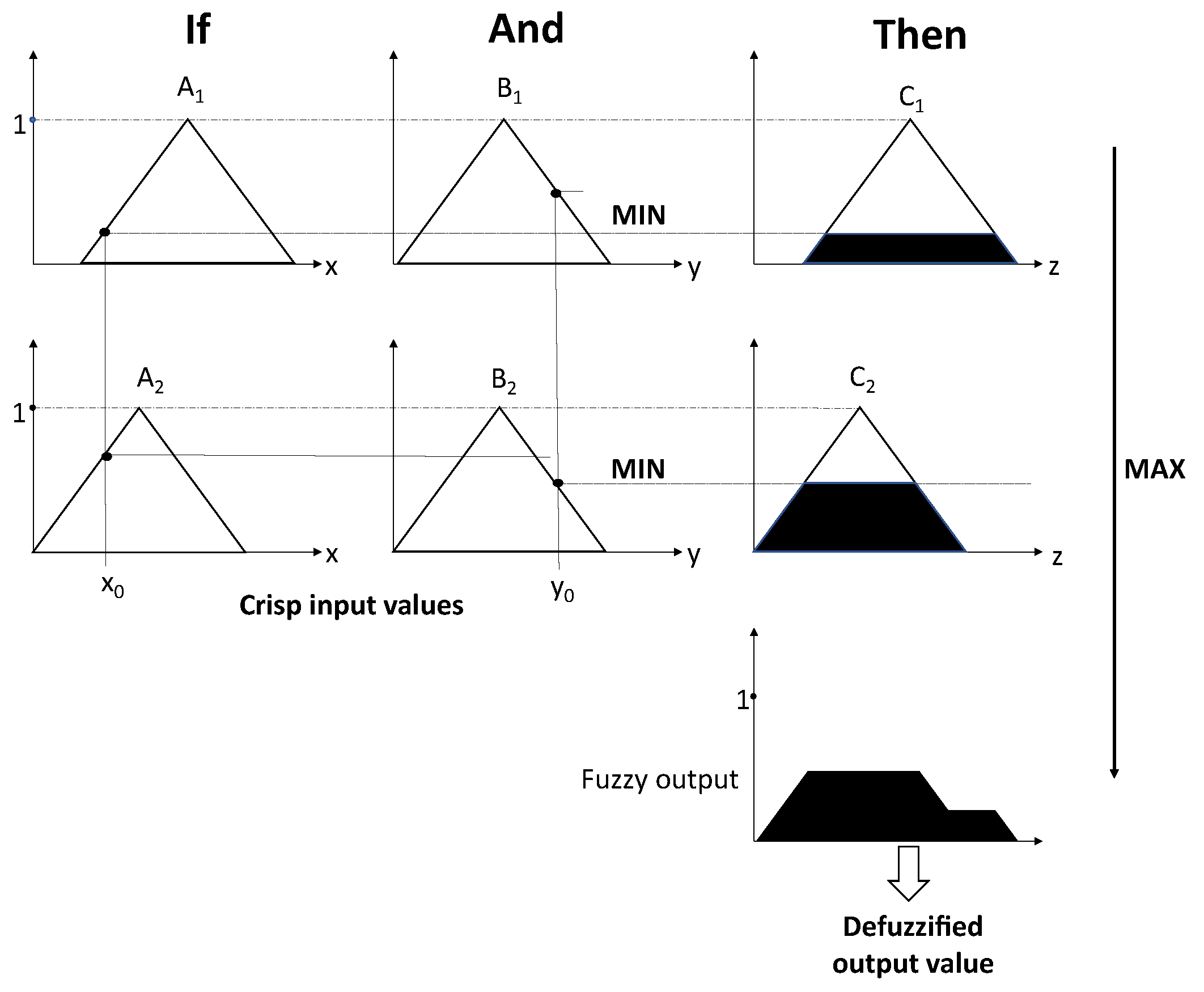

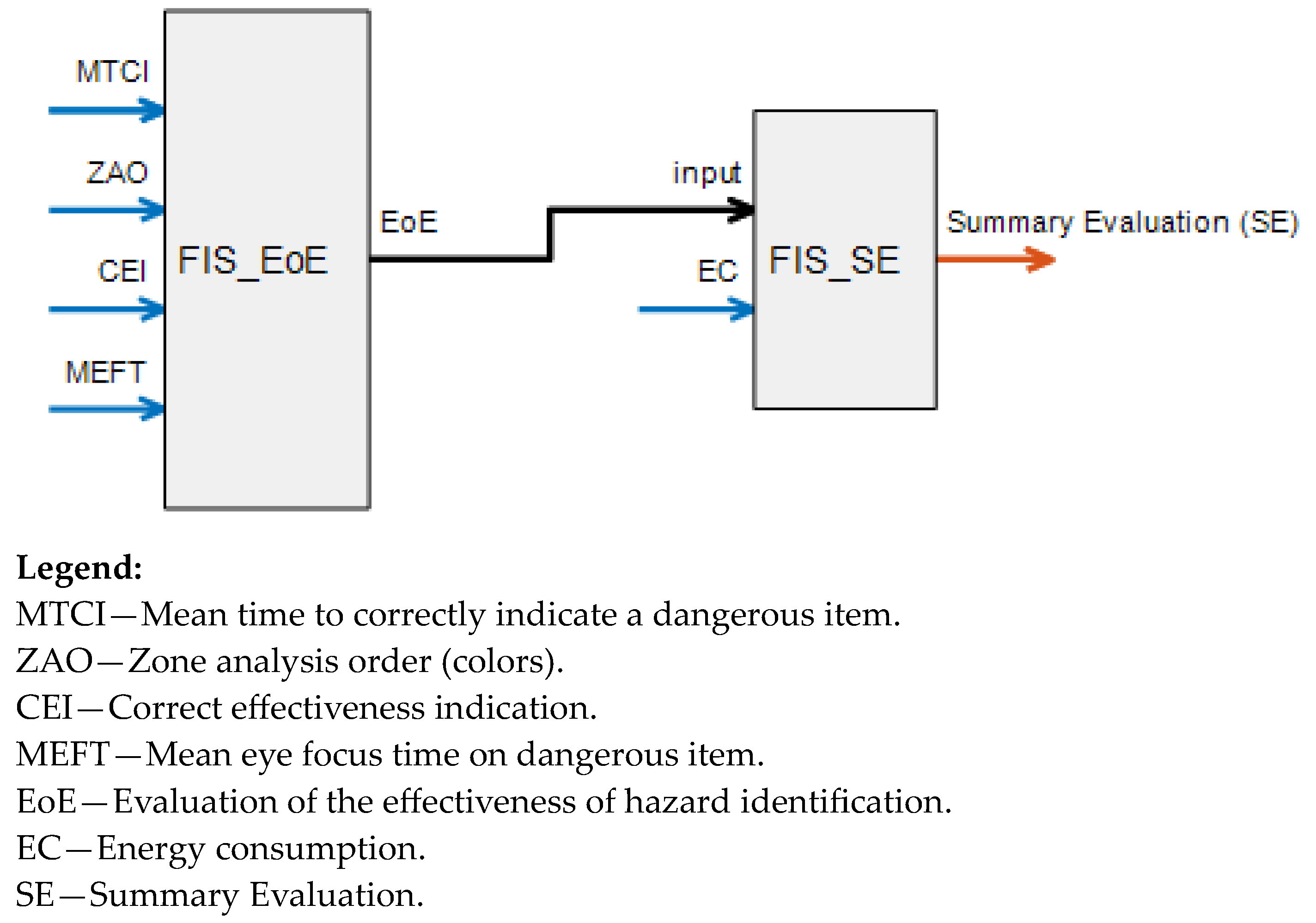
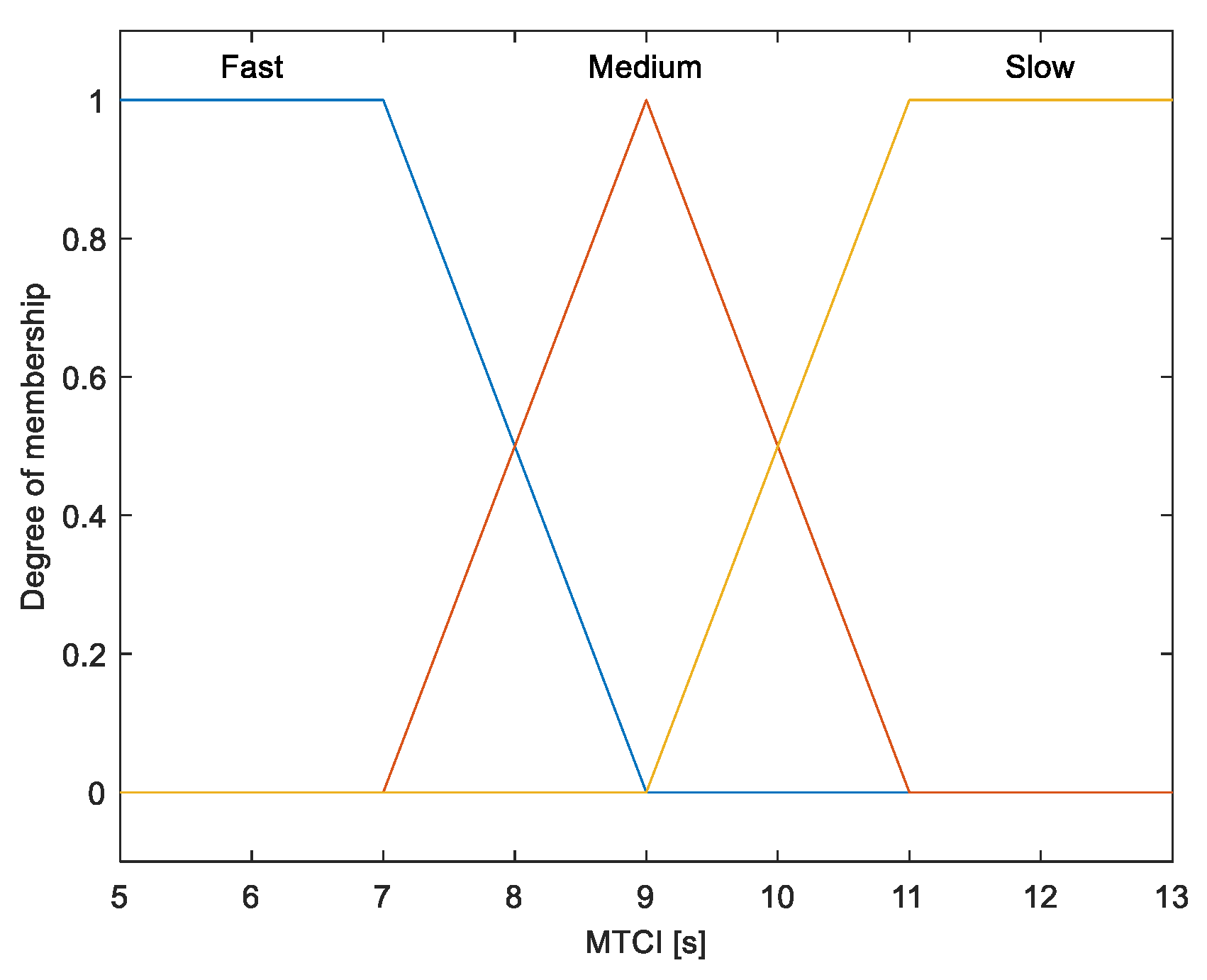
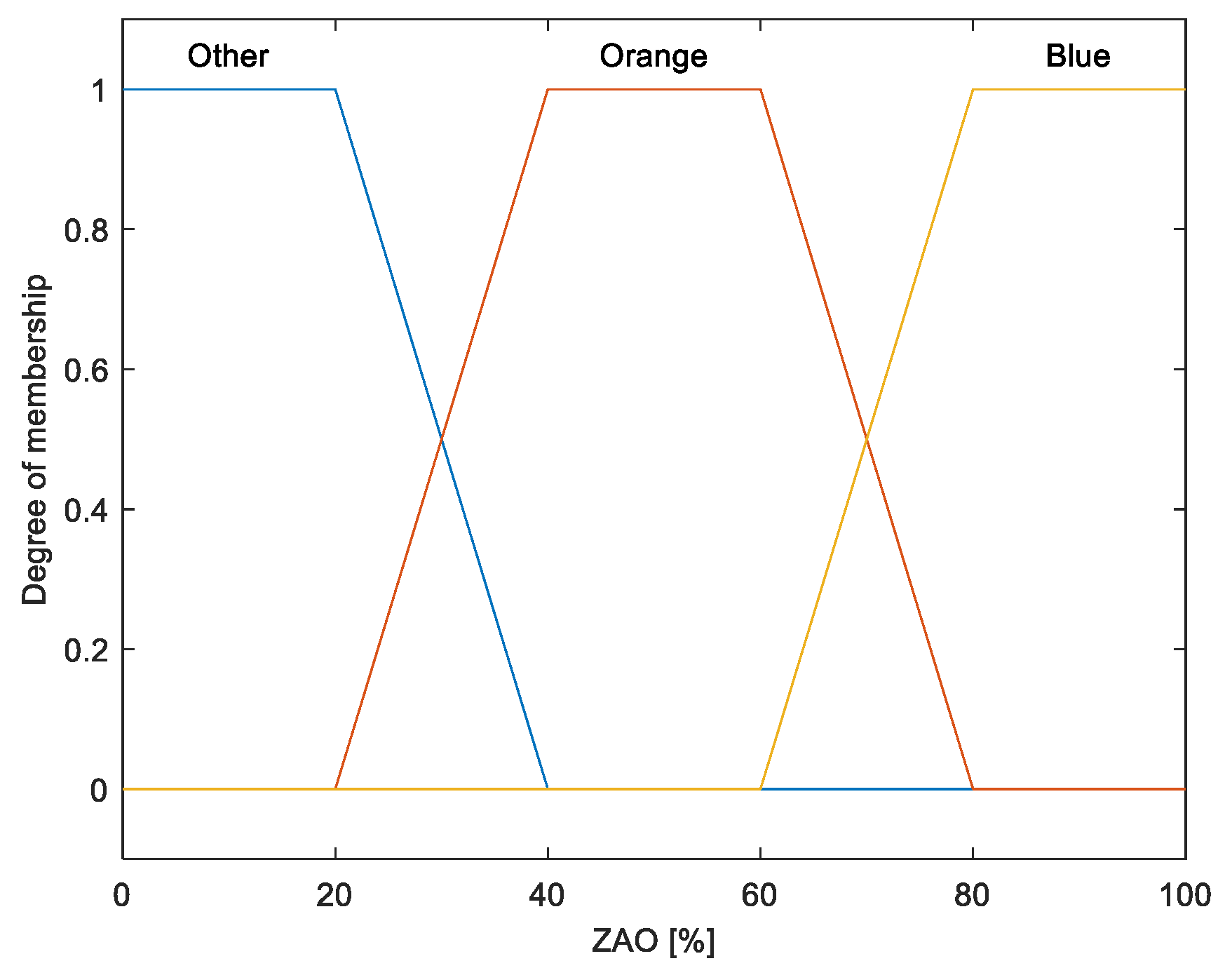
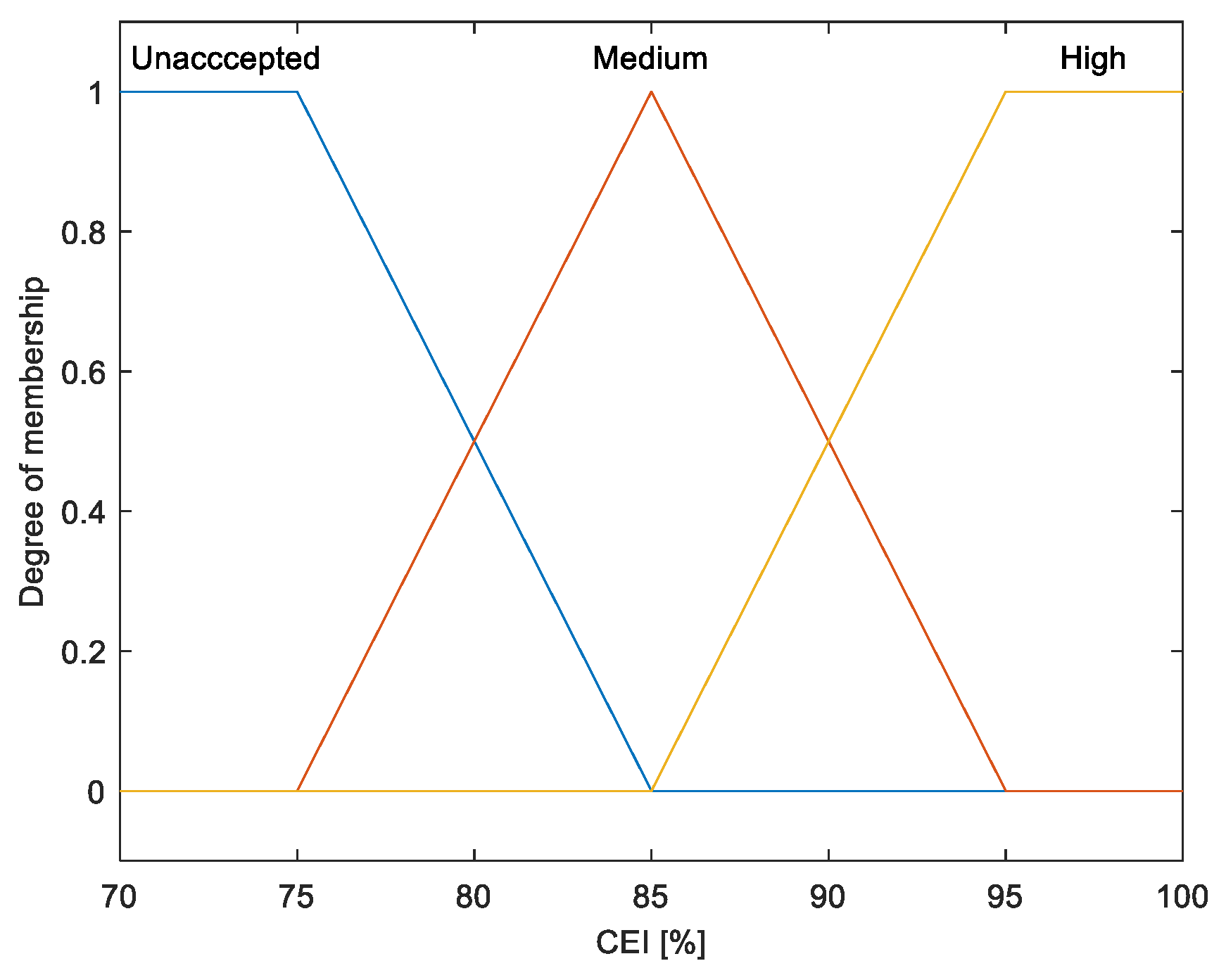

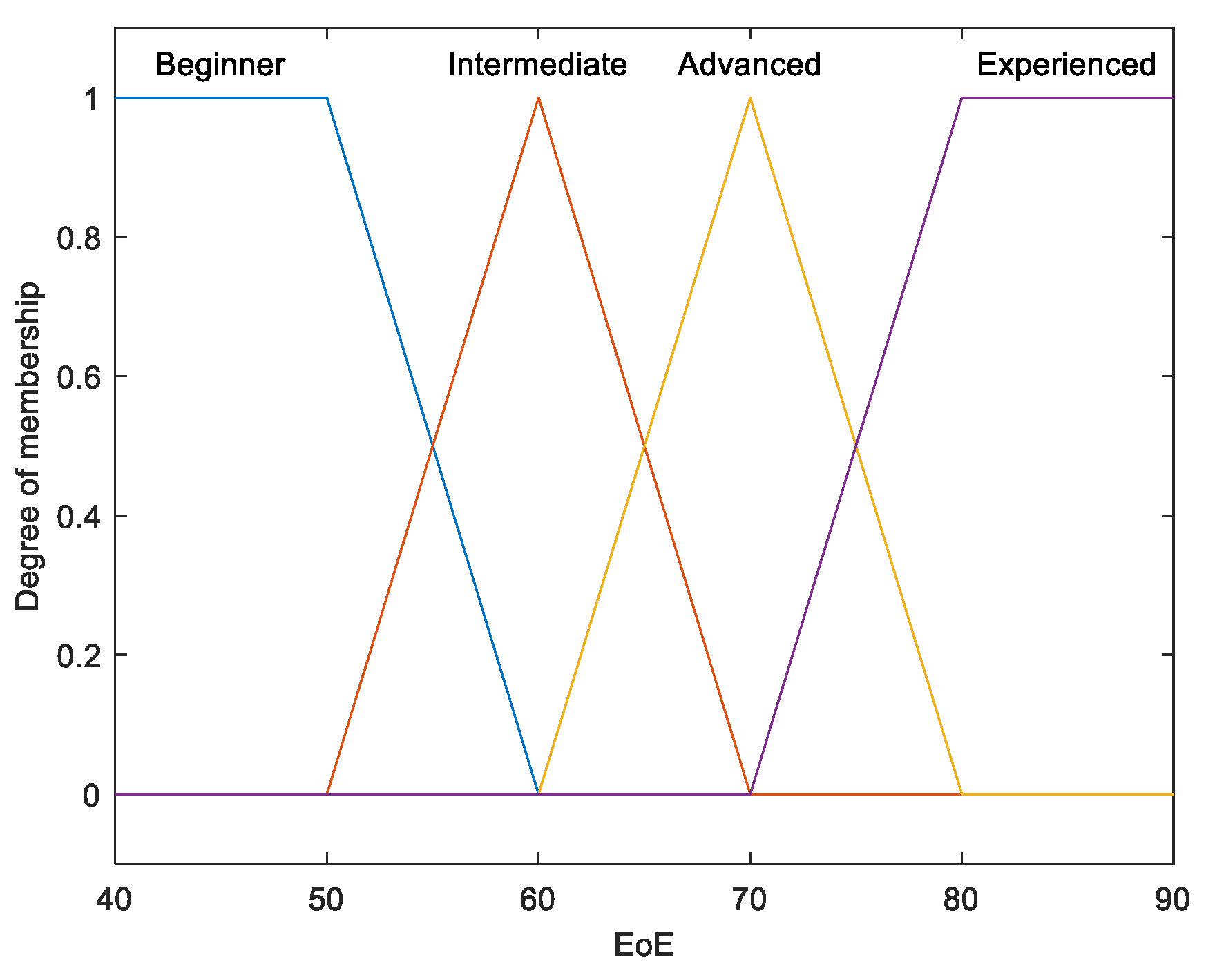
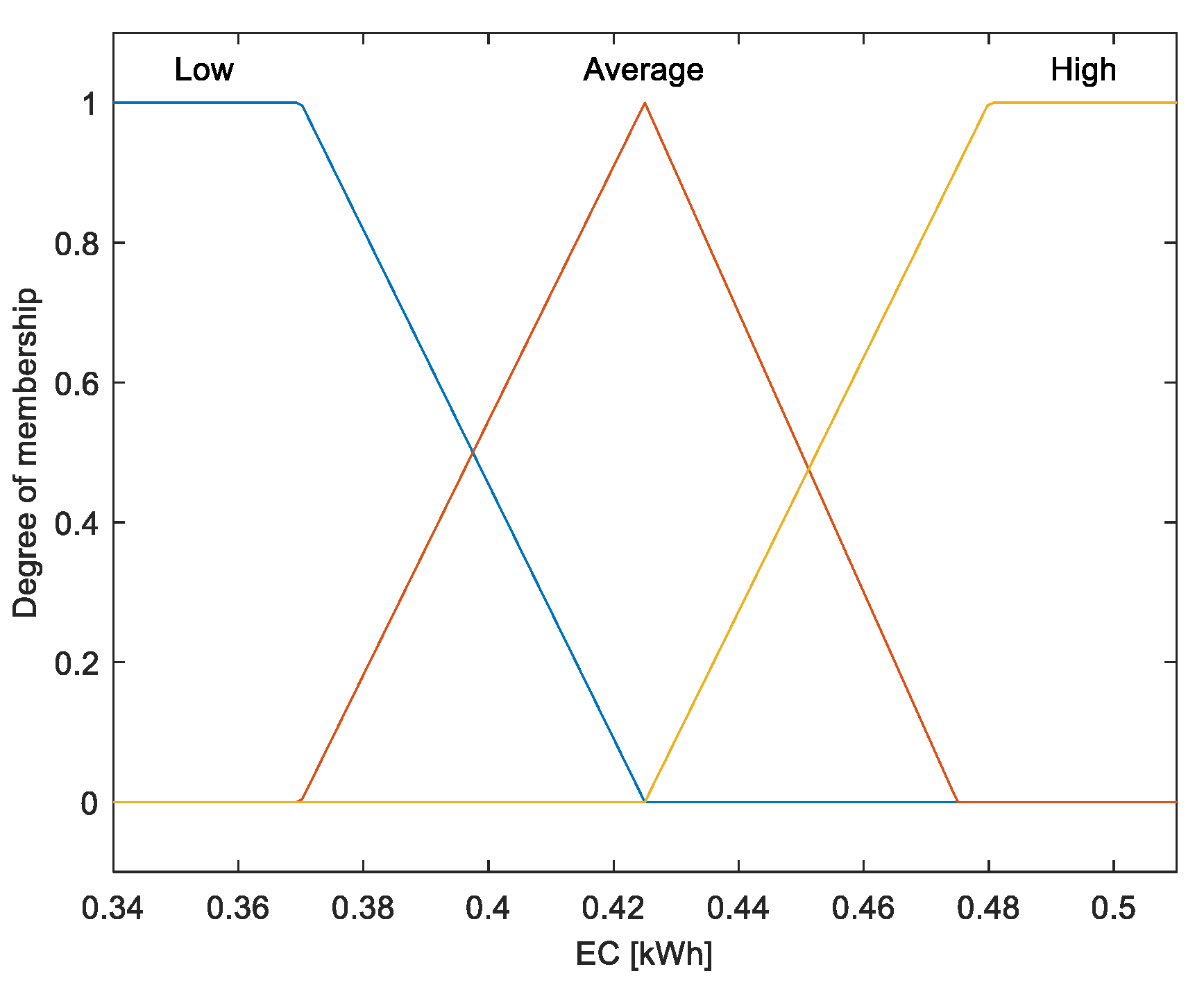
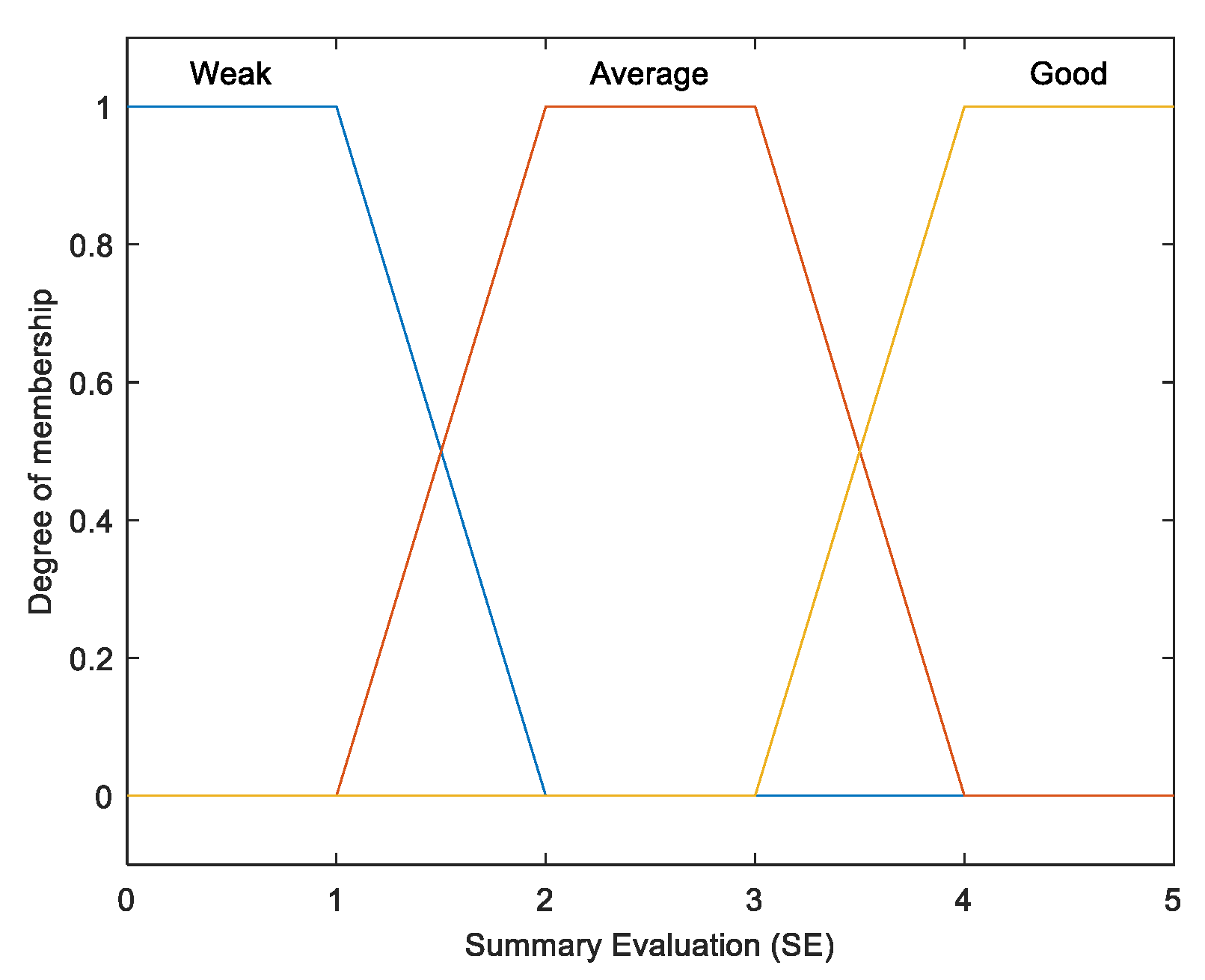
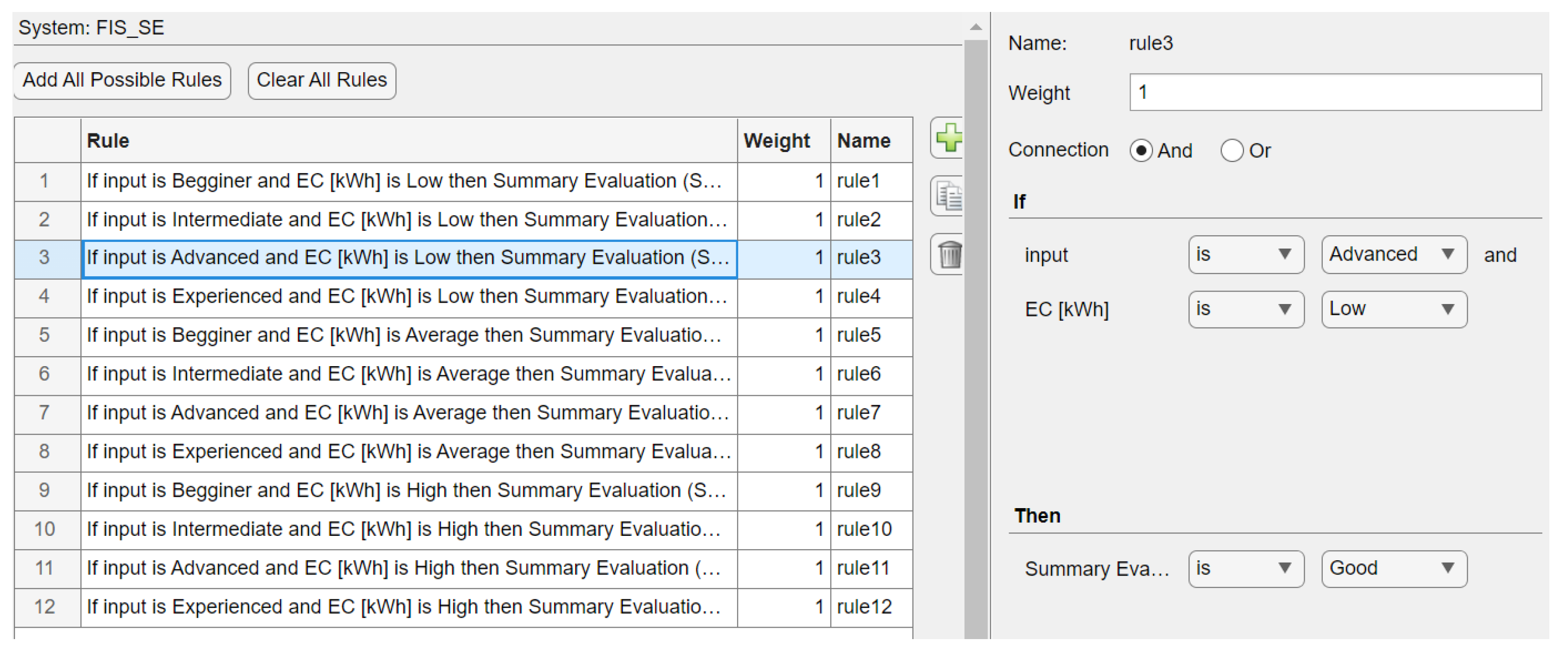
| No. of SCO | Experience in Position (Months) | The Value of the Parameter (Variable) Obtained in the Test | EC * (kWh) | SE | ||||
|---|---|---|---|---|---|---|---|---|
| MTCI (s) | ZAO (%) | CEI (%) | MEFT (s) | Summary Time of Sessions (s) | ||||
| Group 0 ÷ 24 months of experience in the position | ||||||||
| 1 | 7 | 11.22 | 47 | 77 | 5.11 | 3123 | 0.45 | 1.95 |
| 2 | 9 | 10.56 | 48 | 79 | 7.23 | 2756 | 0.46 | 1.71 |
| 3 | 6 | 11.65 | 39 | 81 | 7.56 | 3154 | 0.45 | 1.89 |
| 4 | 7 | 10.82 | 48 | 77 | 8.33 | 3100 | 0.45 | 2.00 |
| 5 | 14 | 10.76 | 56 | 76 | 5.45 | 2974 | 0.45 | 1.99 |
| 6 | 9 | 12.03 | 43 | 78 | 7.41 | 2843 | 0.45 | 1.91 |
| Group 24 ÷ 90 months of experience in the position | ||||||||
| 7 | 48 | 9.11 | 65 | 79 | 8.56 | 2343 | 0.39 | 3.22 |
| 8 | 34 | 8.03 | 76 | 86 | 7.65 | 2245 | 0.38 | 3.47 |
| 9 | 32 | 9.31 | 67 | 96 | 5.44 | 2346 | 0.39 | 3.25 |
| 10 | 56 | 9.77 | 72 | 77 | 5.76 | 2567 | 0.41 | 2.87 |
| 11 | 48 | 8.44 | 66 | 88 | 6.43 | 2134 | 0.39 | 3.76 |
| 12 | 35 | 7.56 | 69 | 83 | 6.66 | 2056 | 0.37 | 4.03 |
| Group 90 ÷ 150 months of experience in the position | ||||||||
| 13 | 120 | 6.11 | 88 | 97 | 5.12 | 1536 | 0.31 | 4.24 |
| 14 | 96 | 7.07 | 74 | 92 | 5.83 | 1765 | 0.35 | 4.20 |
| 15 | 123 | 6.33 | 71 | 94 | 5.44 | 1654 | 0.33 | 4.17 |
| 16 | 134 | 5.45 | 89 | 92 | 4.08 | 1438 | 0.28 | 4.24 |
| 17 | 135 | 6.11 | 87 | 96 | 5.23 | 1546 | 0.31 | 4.24 |
| 18 | 94 | 6.34 | 66 | 94 | 5.06 | 1747 | 0.35 | 4.15 |
| No. of SCO | Experience in Position (Months) | EC per Day (8 h) (kWh) | Mean EC per Day in Group (kWh) | Weekly EC per One SCO * (kWh) | Yearly EC per One SCO ** (kWh) |
|---|---|---|---|---|---|
| Group 0 ÷ 24 months of experience in the position | |||||
| 1 | 7 | 0.45 | 0.45 | 2.25 | 135 |
| 2 | 9 | 0.46 | |||
| 3 | 6 | 0.45 | |||
| 4 | 7 | 0.45 | |||
| 5 | 14 | 0.45 | |||
| 6 | 9 | 0.45 | |||
| Group 24 ÷ 90 months of experience in the position | |||||
| 7 | 48 | 0.39 | 0.39 | 1.95 | 117 |
| 8 | 34 | 0.38 | |||
| 9 | 32 | 0.39 | |||
| 10 | 56 | 0.41 | |||
| 11 | 48 | 0.39 | |||
| 12 | 35 | 0.37 | |||
| Group 90 ÷ 150 months of experience in the position | |||||
| 13 | 120 | 0.31 | 0.32 | 1.60 | 96 |
| 14 | 96 | 0.35 | |||
| 15 | 123 | 0.33 | |||
| 16 | 134 | 0.29 | |||
| 17 | 135 | 0.31 | |||
| 18 | 94 | 0.35 | |||
| No. of Scenario | Group Experience in Position | No. of SCO | Yearly EC per SCO (kWh) | Summary Yearly EC per 1 Group of SCOs on 1 × RTG Scanner LP * (kWh) | Summary Yearly EC per 3 Groups of SCOs on 1 × RTG Scanner LP (kWh) | Summary Yearly EC per 3 Groups of SCOs on 3 × Lines of Control with RTG Scanner LP (kWh) | Summary Yearly EC for Big Airport with 6 Lines of Control (kWh) |
|---|---|---|---|---|---|---|---|
| 1 | 0 ÷ 24 months | 10 | 135 | 1350 | 4050 | 12,150 | 364,500 |
| 24 ÷ 90 months | 0 | 117 | |||||
| 90 ÷ 150 months | 0 | 96 | |||||
| 2 | 0 ÷ 24 months | 0 | 135 | 1170 | 3510 | 10,530 | 315,900 |
| 24 ÷ 90 months | 10 | 117 | |||||
| 90 ÷ 150 months | 0 | 96 | |||||
| 3 | 0 ÷ 24 months | 0 | 135 | 960 | 2880 | 8640 | 259,200 |
| 24 ÷ 90 months | 0 | 117 | |||||
| 90 ÷ 150 months | 10 | 96 | |||||
| 4 | 0 ÷ 24 months | 5 | 135 | 1260 | 3780 | 11,340 | 340,200 |
| 24 ÷ 90 months | 5 | 117 | |||||
| 90 ÷ 150 months | 0 | 96 | |||||
| 5 | 0 ÷ 24 months | 5 | 135 | 1155 | 3465 | 10,395 | 311,850 |
| 24 ÷ 90 months | 0 | 117 | |||||
| 90 ÷ 150 months | 5 | 96 | |||||
| 6 | 0 ÷ 24 months | 0 | 135 | 1065 | 3195 | 9585 | 287,550 |
| 24 ÷ 90 months | 5 | 117 | |||||
| 90 ÷ 150 months | 5 | 96 |
Disclaimer/Publisher’s Note: The statements, opinions and data contained in all publications are solely those of the individual author(s) and contributor(s) and not of MDPI and/or the editor(s). MDPI and/or the editor(s) disclaim responsibility for any injury to people or property resulting from any ideas, methods, instructions or products referred to in the content. |
© 2023 by the authors. Licensee MDPI, Basel, Switzerland. This article is an open access article distributed under the terms and conditions of the Creative Commons Attribution (CC BY) license (https://creativecommons.org/licenses/by/4.0/).
Share and Cite
Ryczyński, J.; Kierzkowski, A. The Impact of the Level of Training of Airport Security Control Operators on the Energy Consumption of the Baggage Control Process. Energies 2023, 16, 6957. https://doi.org/10.3390/en16196957
Ryczyński J, Kierzkowski A. The Impact of the Level of Training of Airport Security Control Operators on the Energy Consumption of the Baggage Control Process. Energies. 2023; 16(19):6957. https://doi.org/10.3390/en16196957
Chicago/Turabian StyleRyczyński, Jacek, and Artur Kierzkowski. 2023. "The Impact of the Level of Training of Airport Security Control Operators on the Energy Consumption of the Baggage Control Process" Energies 16, no. 19: 6957. https://doi.org/10.3390/en16196957







